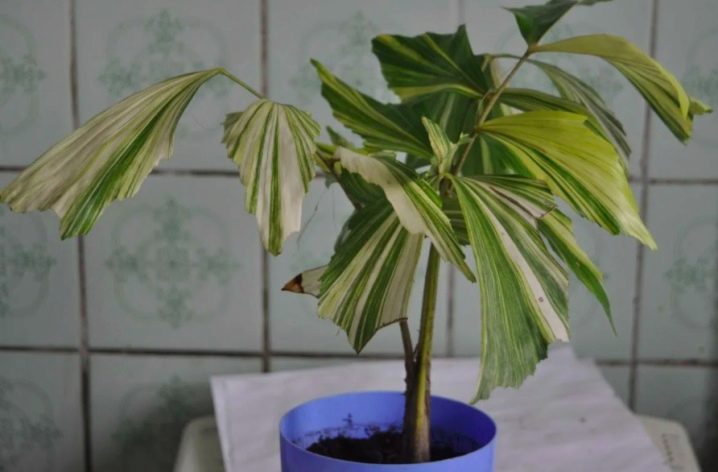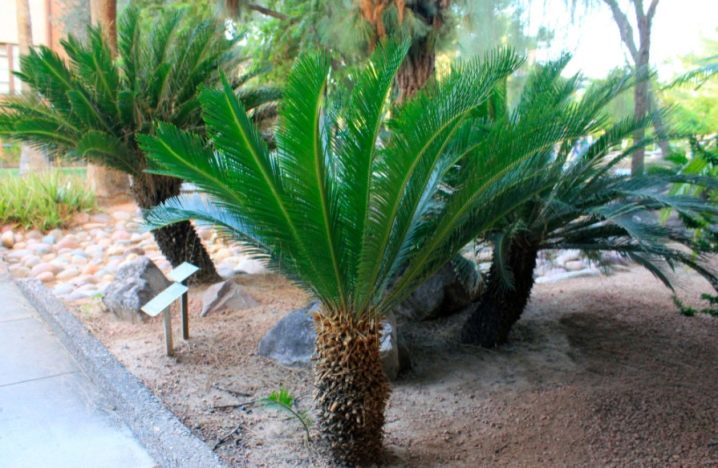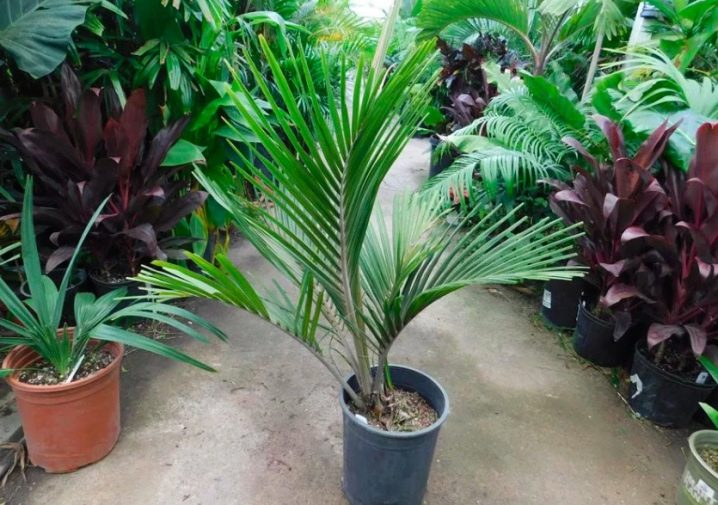Types and varieties of palm trees

Potted palms are among the most popular houseplants. They are easy to grow and have unique decorative qualities; they are an outstanding decoration both in apartments and on plots. Some grow quickly and require transplanting, while others grow more slowly and do not take much time to care. To understand which palm tree will look best for you, consider the most common varieties from America, Mexico, China and the islands.
Brachea and its description
The homeland of the brachea is America, most often it can be found in Mexico. The maximum height it reaches is 15 meters. The plant is characterized by the presence of a silvery-blue wax coating on the foliage. This is a kind of sun protection.

The greens of the brachea are tough, fan-shaped. When forming a full-fledged crown, a palm tree can have up to 80 branches.
This variety has good frost resistance, can withstand up to -18 degrees Celsius.

The brachea produces large seeds, some as large as hazelnuts. When planted, they can germinate within a few weeks, and sometimes sprouts appear only after a year. The ground for the brachea must be constantly wet, therefore, mulching of the trunk circle is often used.


Features of the boutique
It is also called the Marmalade Palm. If we talk about the natural environment, it can grow up to 6 meters in height, the trunk diameter is up to 500 mm. One of the specific features is the presence of a capitate thickening at the base.

The foliage is long-petiolized, very tough. Its length can be up to 4 meters. Consists of lobes, shade of gray-green. Adult leaf petioles have thorns, while they are young, they will have felt on them.
By the end of spring or early summer, the palm tree begins to bloom. The inflorescence is spicate, loose, its length is 1.4 m. The flowers are red. Fruit ripening begins in mid-autumn. They are similar in shape to apricot and can be used to make jam.

What does washingtonia look like?
It is a perennial woody plant that blooms quite rarely and has an average growth rate. With proper care, Washington can live up to 15 years.

Mexico and the USA are considered the birthplace of this palm tree. Refers to a fan type plant, since the foliage is split into segments. In the wild, the leaves of Washingtonia reach a diameter of 1.5 m. This plant can reach a height of 30 m. At home, Washingtonia rarely grows more than 4 meters. You can wait for the appearance of flowers only after 10 years, or even more.


Other popular varieties and their varieties
There are many types of domestic or indoor palm trees. They are used to decorate the interior and fit perfectly into any design. At the same time, it is not easy to grow such a tree; it is necessary to provide it with the necessary care. There are also outdoor ornamental plants used in landscaping.
There are green palms that look more like shrubs. This is a wonderful landscaping on the site.



Gioforba
The bottle palm gioforba is rarely seen in the apartment. This is because it is not easy for this plant to grow and provide care at home, so it is not very suitable for the home.
The perennial plant remains permanently green. In nature, it is common on the Mascarene Islands. The genus described includes five species, all of which rarely reach 6 meters in height.
It should be said that this is one of the rare varieties that are protected today.

It is worth giving a more detailed description of the palm tree. It is very compact, with age, the trunk swells, as it were.
The crown is formed lush, the rosette may consist of 4 leaves, their number reaches 8, depending on the conditions in which the gioforba grows. The foliage is plumose, large, can reach 3 meters.
The flower is small, white, always in an inflorescence. Fruits are formed on a palm tree over time, their diameter is up to 5 cm, the color is black, the shape is rounded.

Hovea
This plant is very popular with flower growers. It is ideal for home cultivation, but there are certain rules for how to care for this variety.
Hovea needs to be given warmth, and provide the required amount of light. They began to cultivate this plant in the Victorian era, in nature it reaches 15 meters in height, but in an apartment it is usually no more than 3 meters.

The plant is characterized by the formation of a large number of basal shoots. Over time, a powerful trunk will appear. Hovea grows slowly, only 3 new leaf plates are formed per year.
The optimum temperature for growing in summer is 22-23 degrees, in winter 13-18 degrees Celsius. Water the plant abundantly, in the summer 1-2 times a week, in the winter after 2-3 weeks. Leaves are moistened with soft water every 3-4 days through a spray bottle. Fertilize the hoveya once a week in the summer and once a month in the winter. Drying leaves may mean that the air in the apartment is too dry and the temperature is too high. This species reproduces from seeds.

Karyota
This variety belongs to single-stemmed palms. It happens 5-6 meters in diameter. A large number of small flowers are created on the inflorescences. From the age of 12, it begins to bloom. Duration of flowering can take up to 5-7 years. And after the fruits are ripe, the plant dies.
It blooms very rarely in apartments. When growing this palm, a lot of sun and air temperatures above 15 degrees are recommended. They plant a palm tree in a soil mixture of earth, peat and sand. Drainage is needed at the bottom of the pot. Requires a lot of water and frequent fertilizing. The plant reproduces from seeds that quickly lose their germination, so they should not be stored for long.

Dracaena
A tropical plant from the asparagus family that came to us from Africa. It owes its popularity to its attractive appearance. The shrub has bright green foliage. The stem turns into woody over time. In a state of full maturity, a palm tree can reach 2 meters. This shrub lives from 5 to 15 years.

Raffia
An evergreen plant, easily recognizable by experienced growers. It has the largest leaves of any species. It grows in America. In nature, it reaches 16 meters. After the fruits ripen, the palm tree dies, but there are also such species in which only some shoots die off.

Bertamova
Bertham palm grows in Malaysia. There it can reach 6 meters. It is quite difficult to keep such a plant at home, since its aerial roots can grow up to 3 meters. When this palm tree blooms, it gives off a sweet nectar rich in alcohol. The variety stands out for its high growth rate.

The number of this family is about 200 species. In modern houses, the Tsikas drooping palm tree has especially taken root, since it is not too whimsical.
The plant grows in Madagascar and Asia. The cycad palm has a thick trunk with a very spreading crown of feathery leaves. Such a palm tree lives in the house for a long time and replaces more than one generation. The maximum height in an unnatural environment is 15 meters. It grows slowly, about 3 cm per year.

Cordilina
This perennial plant belongs to the agave family. Loves the tropics and subtropics, can be found in Australia and Brazil. In nature, the tree grows powerful, spreading up to 16 meters. In the room, the palm tree will grow slowly.
The long leaves represent the greatest decorative value of this plant. The flowers are white and inconspicuous; they rarely appear in apartments. The palm tree requires a place with diffused light, moderate watering in summer (only when the substrate is dry) and very rarely in winter. The required temperature in summer is from 20 to 25 degrees, in winter from 7 to 10 degrees. We fertilize the tree every 3 weeks from March to September. In summer, can be displayed on a slightly shaded balcony or terrace.

Amorphophallus
This amazing plant does not grow in the house and belongs to the lily family. Known as a cadaveric flower. It produces a giant peduncle, but only once every 40 years. Such a flower can be up to 3 meters high.
The specific smell is a distinctive feature of this plant. It grows in Indonesia and China.

Livistona
The family of this palm contains about 30 species. Of the distinctive features of the Livistons, a bare trunk is only up to 2 meters high. It is prized for its large, fan-shaped leaves. This is a great solution for decorating an apartment or garden.

Rapis
A low-growing plant of a fan type, in which a tubular trunk is formed. It came to us from China and Japan, but can be found in other countries around the world. The subtropical climate is ideal for this palm tree. There are pronounced fibers on the trunks.

Ropalostilis
Outwardly, this palm can be recognized by the green leaf scars that are on the trunk. The maximum height that a tree reaches is 15 meters. The diameter is usually about 250 mm.
Most often seen in New Zealand and the Sounds Islands, Nelson. Under proper conditions, fruits and leaves grow quite large, covered with tough fibers.

Tsikas
This palm tree came to us from Southeast Asia. It grows slowly at home and requires a lot of attention. You will not be able to grow this plant on heavy soil. At low air temperatures, an abundance of moisture leads to immediate root rot.

Sabal
This is a rather tall palm tree, up to 30 meters, with a trunk diameter of up to 600 cm. The foliage remains constantly green, split to the base into plates. There are no thorns on the petioles, the leaves are also without needles.

Trachikarpus
This type of palm tree has a vertical trunk on which remains of old foliage remain. The crown is decorated with green leaves, the diameter of which reaches 800 mm. Petioles grow up to 1 meter long, there are thorns. Young palms do not have a trunk, foliage grows from the root, it is formed later.
The leaves of this palm tree form deeply divided fans as they grow. During the season, this tree is watered moderately; in winter, it is required to reduce the moisture rate. In the spring and summer, fertilize once every 3 weeks with liquid fertilizer. For the summer, the palm tree can be exposed outside in an area protected from the wind. This type of palm can only be propagated from seeds that germinate very slowly.

Date
They began to cultivate a palm tree of this variety back in the 4th millennium, where Iraq is now located. The tree has one trunk, the foliage is quite long, and there are thorns at the base.
It blooms with small yellow flowers that gather in an inflorescence.

Hamedorea
The bamboo palm tree can grow in the shade, is undemanding to care for and feels great in the house. She came to us from Mexico and America. Trees are prized for their grace, low height and unique decorative qualities. The barrel is usually about 30 mm thick.
Loves low temperatures - in winter 15, and in summer 16-20 degrees Celsius. Drought tolerant. Reacts well to spraying leaves with soft water. Fertilize the plant every 14-20 days. Transplanted in the spring every two years. Propagated by seeds. Darkening of the tips of the leaves indicates dryness.

Hamerops
In its natural environment, hamerops can grow up to 600 cm, but indoors it is rarely more than 2 meters. One of the main advantages of this palm tree is beautiful, carved leaves sitting on meter-high petioles. There are hard fibers on the trunk. If flowers appear, then they are inconspicuous, of a pale yellow hue. In summer, liquid fertilizers are required every 2 weeks. The palm should be repotted in a larger pot every two years.

Red palm
Originally from Malaysia, it is distinguished by beautiful feathers of dark green leaves. In the wild, this palm reaches 6 m in height, but when grown in a pot, it is much lower. Prefers a place with a lot of ambient light. Loves fertile soil, light. Its base must be constantly damp. Needs high air temperature - 20-35 degrees Celsius. The plant is fertilized every two weeks, and bred from seeds.




































































The comment was sent successfully.